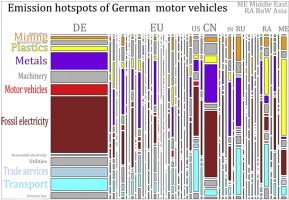Journal of Cleaner Production ( IF 9.7 ) Pub Date : 2018-05-17 , DOI: 10.1016/j.jclepro.2018.05.003 Kirsten S. Wiebe

|
Data on consumption-based CO2 emissions has become increasingly available over the past years. These data raise the awareness of the link between final goods and the environmental pollution caused by upstream production processes. Consumers of final products learn where in the world CO2 was emitted along the upstream production chain. For producers of final products these data provide benchmarks for total CO2 emitted in upstream production processes. These are used together with an extended version of the inverse important coefficient methodology to identify ‘emission hotspots’. ‘Emission hotspots’ are defined as countries/industries where a bulk of the upstream emissions occur and where a change in technology brings about the largest decrease in upstream emissions. This knowledge provides a basis for well-targeted technology transfers to clean up the upstream production chain, thus reducing the emission footprint of final goods production. The highest impact overall in a significant number global value chains analyzed here would be replacing upstream use of coal electricity by low carbon electricity. These results support the call of the ‘Powering Past Coal Alliance’ at the COP23 of ending the use of coal power sooner rather than later.
中文翻译:

确定低碳技术转让的排放热点
在过去的几年中,基于消耗的CO 2排放的数据越来越多。这些数据提高了人们对最终产品与上游生产过程造成的环境污染之间联系的认识。最终产品的消费者了解世界上上游生产链中的CO 2排放量。对于最终产品的生产商,这些数据提供了总CO 2的基准在上游生产过程中排放。这些与反重要系数方法的扩展版本一起使用,以识别“排放热点”。“排放热点”定义为发生大量上游排放且技术变化带来最大上游排放减少的国家/行业。这些知识为有针对性的技术转让提供了基础,以清理上游生产链,从而减少了最终产品生产的排放足迹。在本文分析的大量全球价值链中,总体上最大的影响将是用低碳电力代替上游的煤炭电力使用。这些结果支持COP23提出的“推动过去的煤炭联盟”的呼吁,即尽早停止使用煤电。







































 京公网安备 11010802027423号
京公网安备 11010802027423号